As most readers are undoubtedly aware, today is National Feral Cat Day. And at the risk of stating the obvious: NFCD has clearly become, to borrow a trendy phrase from social media, “a thing.” Now in its 14th year, there are hundreds of events going on around the country to mark the occasion.
All of which must be terribly frustrating for TNR-deniers. Thus, their increasingly desperate attempts to oppose, any way they can, TNR and community cat programs.
Witness, for example, Cats, Birds, and People: The Consequences of Outdoor Cats and the Need for Effective Management (PDF), a presentation by Grant Sizemore—who may or may not be the American Bird Conservancy’s Director of Invasive Species Programs. (As we’ll see shortly, it’s surprisingly complicated.)
It’s not clear exactly who these 33 slides are intended to help. After all, to anybody even remotely familiar with the issue, it’s immediately apparent that Sizemore’s claims—the “consequences” mentioned in the presentation’s title—are flimsy at best.
Equally apparent: Sizemore and ABC are not—though ABC’s been on this witch-hunt for 17 years now—about to provide any solutions.
Not only is the presentation available on ABC’s website, Sizemore’s now taking the show on the road. Last month, for example, he was in Ellenton, Florida, as part of a Coyotes and Feral Cats forum, hosted by the Suncoast Cooperative Invasive Species Management Area.
No doubt, most readers will miss such opportunities. Here, then, are 11 of the presentation’s “highlights”—my humble gift on National Feral Cat Day 2014.
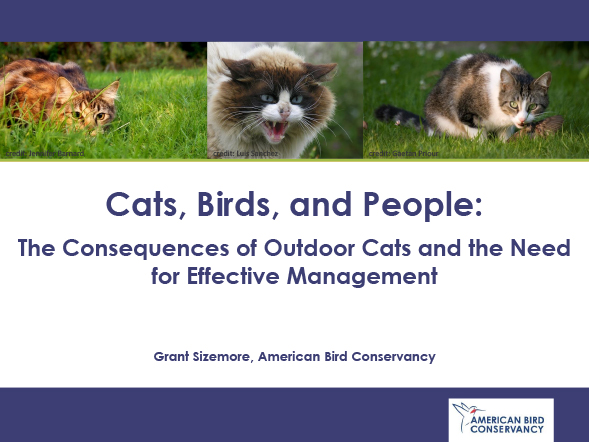
1. Seriously? We can’t even get past the first slide? No.
Where’s Sizemore’s title? Could be a simple oversight, of course. Or maybe not—Sizemore’s title actually seems to be very much in flux these days. In their July newsletter (PDF), ABC referred to him as their “Cats Indoors Program Officer.” A month later, though, Sizemore signed his letter to the Escambia County Board of County Commissioners “Director of Invasive Species Programs,” a title he retained for his September 9 presentation to the Suncoast CISMA folks.
But less than three weeks later, in his letter to The Baltimore Sun (to which I responded with a letter of my own), Sizemore was “Cats Indoors Program coordinator for the American Bird Conservancy.”
One has to wonder if perhaps Sizemore’s title depends on the audience (and funding—the endless pursuit of “invasive species” is surely more lucrative) ABC is trying to reach. Sounds far-fetched, sure, but you know: desperate times.
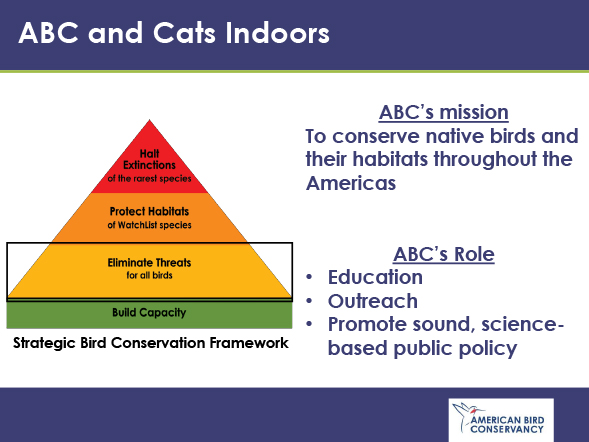
2. Sacrificing science for ideology
For anybody who’s spent more than, say, 15 minutes reading this blog, the claim that ABC is “promot[ing] sound, science-based public policy” is laughable. Or it would be, if the consequences weren’t so dire.
Indeed, as we’ll see shortly, Sizemore’s presentation is a showcase of pseudoscience, misrepresentations, red herrings, scaremongering, and flat-out errors. Typical ABC, in other words.
All of which raises an awkward question: how can this kind nonsense actually advance their mission to conserve native birds? Put another way: if Sizemore and ABC got their way—greatly restricting or completely eliminating TNR—how could that possibly benefit the birds they claim to protect? The answer is, I think, rather obvious—though you’re not likely to hear it from ABC.
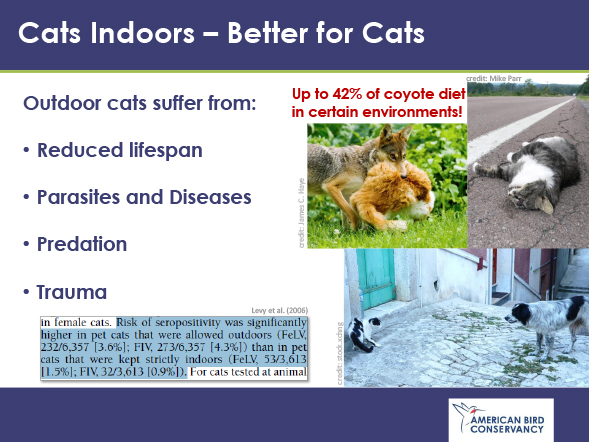
3. Disingenuous concern for the welfare of cats
Cats make up 42 percent of coyotes’ diet? I suppose it’s possible, depending on which “certain environments” we’re talking about. In this case, it was Tucson, Arizona, and the study Sizemore’s referring to—whether he knows it or not—didn’t even attempt to quantify coyotes’ diet in this way. Of the “45 instances of coyotes consuming prey and fruit” [1] documented by the researchers involved, 19 (42 percent) involved cats.
Why so many? As the paper’s authors explain, their “objectives were to describe the group size of coyotes involved in coyote–cat interactions, time and location of interactions, and outcomes of interactions.” [1] They were not conducting a survey of what coyotes eat.
But that’s not the only problem with Sizemore’s statement.
The Tucson project documented consumption based on frequency of occurrence—the researchers merely tallied cats, rodents, and so on. This is very different from estimating the percentage each category makes up in the overall coyote diet.
What Sizemore has done—repeating a mistake that was corrected long ago, and publicly—is akin to suggesting that coffee makes up 63 percent of the American diet based on survey results that 63 percent of Americans drink coffee daily.
It’s difficult to see how “sound, science-based public policy” is going to come from such analytical blunders.
And Sizemore’s apparent concern over FIV and FeLV? Again, this would be laughable if the consequences of ABC’s long-running witch-hunt weren’t so dire: if ABC is so concerned about the risks of these diseases, why not promote TNR? After all, multiple studies [2-4] have demonstrated that the infection rates in colony cats are “similar to infection rates reported for owned cats.” [2]
Sure, cats who spend time outdoors are at increased risk, but is this risk really sufficient to warrant the sort of lethal roundup ABC’s long-time president George Fenwick recommended last year in The Baltimore Sun?
“Local governments need to act swiftly and decisively to gather the 30 million to 80 million unowned cats, aggressively seek adoptions, and establish sanctuaries for or euthanize those cats that are not adoptable.” [5]
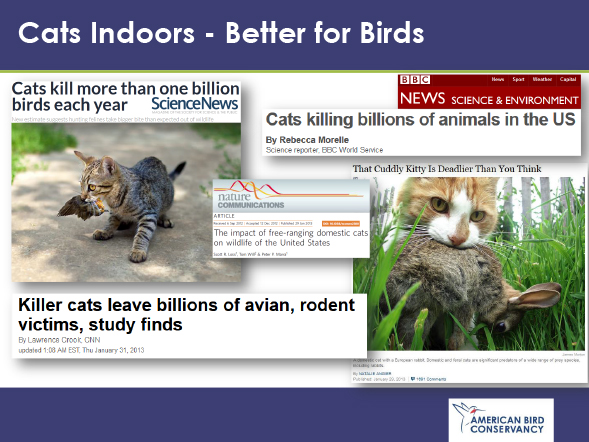
4. Unwavering support for agenda-driven pseudoscience
As I’ve discussed at some length, the 2013 paper published in Nature Communications is nothing more than agenda-driven, publicly funded pseudoscience—statistical modeling based on assumptions that simply can’t be taken seriously by anybody familiar with the relevant literature.
Of greater interest is Sizemore’s choice of imagery. According to the caption for the photo accompanying the New York Times story, that’s a European rabbit—which, Wikipedia explains, “is a species of rabbit native to southwestern Europe… and northwest Africa… [that] has been widely introduced elsewhere, often with devastating effects on local biodiversity.” This should be of some concern to ABC’s Director of Invasive Species Programs, no?
I mean, if that’s still his role with the organization.
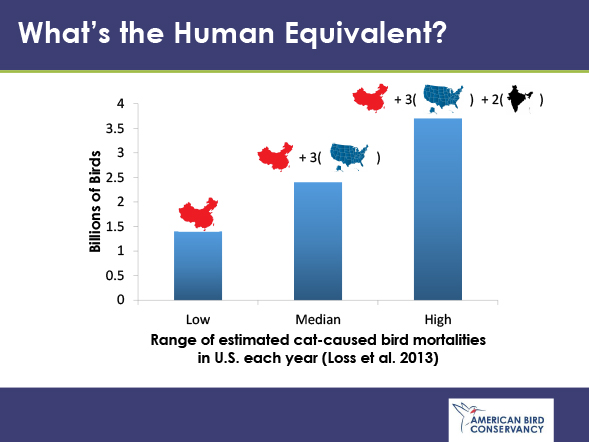
5. Not just meaningless, but also truly bizarre comparisons
Possibly my favorite slide in the entire presentation. Comparing bogus bird mortality figures to human populations—what’s the point? A far more relevant comparison would be to compare the fictional figures invented by researchers at the Smithsonian Conservation Biology Institute and U.S. Fish and Wildlife Service (some of the same folks who brought us Nico Dauphiné, by the way) to the estimated population of, well… birds. According to a 2004 Partners in Flight report—which bears the logos of both ABC and the U.S. Fish and Wildlife Service—there are an estimated 4.7 billion land birds in North America. [6]
What these researchers—and ABC—are suggesting, then, is that outdoor cats in the U.S. alone are responsible for killing up to 80 percent of the land birds in all of North America. Year in and year out.
No wonder Sizemore avoided this comparison.
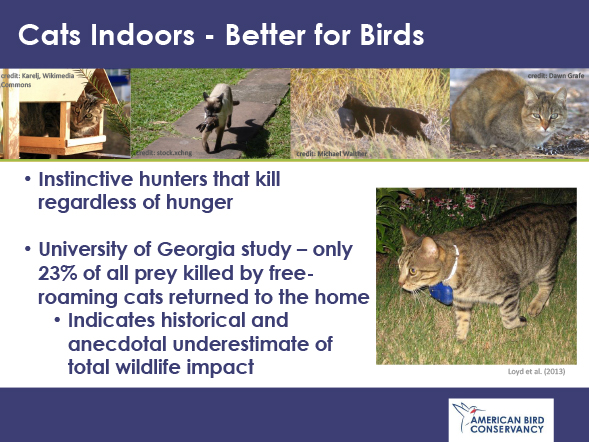
6. Eagerness to grossly inflate predation rates
Naturally, Sizemore and ABC seized on that 23 percent figure—a convenient multiplier suggesting that one can simply multiply prey tallies by four. Read the paper, though, and it’s obviously more complicated than that.
Consider the variety of 39 prey items documented, for example: reptiles (14) mammals (10), invertebrates (8), birds (5), and amphibians (2). It’s quite reasonable to assume that the likelihood of a cat to return prey depends upon what sort of prey we’re talking about—grasshoppers, for example, being more likely to be consumed or abandoned, whereas perhaps larger prey might be more likely to be brought home as a “gift.” Indeed, the authors admit as much: “Individual cats manipulated different prey in more than one way, such that a cat might eat one item, and bring the next one home.” [7]
Unfortunately, the authors don’t provide a complete breakdown of which prey items were returned and which were not, only this: “14 of 16 reptiles and amphibians (88%) were either eaten or left at the capture site.” [7] That accounts for two of the nine prey items returned home; what about the other seven?
Sizemore seems to be implying that none of the five birds were among them, but he has no way of knowing—at least not from the paper he’s referring to here.* Now, if he’s really interested in the findings of the “KittyCam” work (which, regular readers will recall, ABC badly misrepresented in their press release at the time), he ought to at least acknowledge what lead author Kerrie Anne Loyd told CBS Atlanta when she was interviewed about it: “Cats aren’t as bad as biologists thought.” [8]
(That first bullet point, by the way, is almost certainly a reference to the 1976 paper I discussed in my July 19 post—the cats involved in that study were neither well-fed or hunting—though ABC often suggests otherwise.)
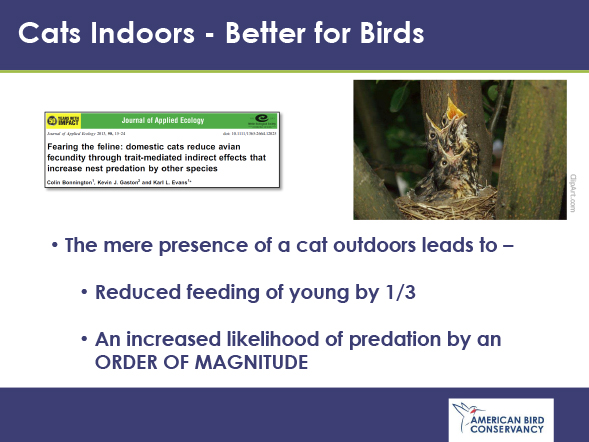
7. Leading the fight against dead cats and children’s toys
Once again, Sizemore seems to have gotten no further than the paper’s abstract. As I explained last year, the methods involved—using taxidermy “models” and plush toys rather than live animals, for example—invalidate the authors’ results and conclusions.
Leave it to ABC to endorse such nonsense.
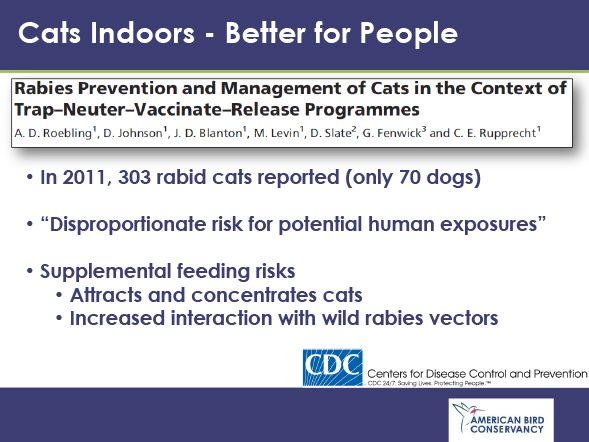
8. Too-cozy relationship with the CDC
Notice how Sizemore focuses on rabies in animals rather than data corresponding to human exposures? Doing so paints a rather different picture. A study of “11 geographically diverse university-affiliated, urban emergency departments,” for example, found that of 2,030 patients enrolled, 1,635 exposures (81 percent) were attributed to dogs, and 268 (13 percent) to cats. [9]
In other words, dog-related exposures were six times as likely to send people to the hospital compared to cat-related exposures.
It’s also interesting that Sizemore’s using 2011 data in a presentation dated 2014—after all, the 2012 figures were made available more than a year ago. And they’re kind of fascinating:
“With the exception of cats, the number of cases of rabid animals reported during 2012 was increased for all species of domestic animals, compared with the number reported during 2011.” [10]
Indeed, the number of rabid cats in the U.S. decreased by 15.2 percent to 257, the lowest since 2000, and only the second time since 1991 that fewer than 260 rabid cats were reported.
Remember the ABC press release? Me neither.
Another bit of information conveniently omitted by Sizemore: despite what’s implied by the CDC logo, the paper’s authors (among them, as it happens, ABC president George Fenwick) state quite clearly: “The findings and conclusions in this report are those of the authors and do not necessarily represent the views of the Centers for Disease Control and Prevention.” [11, emphasis mine]
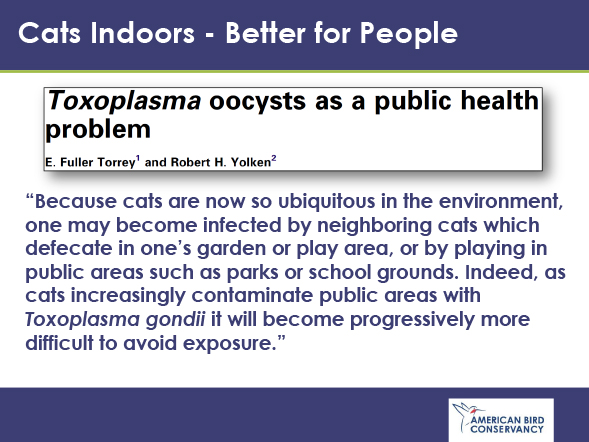
9. Consistently prioritizing messaging over public health
T. gondii is becoming “progressively more difficult to avoid”? Data from the large-scale National Health and Nutrition Examination Survey actually reveal a significant decrease between 1988 and 2010 in age-adjusted seroprevalence of T. gondii among people born in the U.S. Among people 12–49 years of age: 1988–1994: 14.1 percent; 1999–2004: 9.0 percent; 2009–10: 6.6 percent. [12]
Yet surveys by the American Veterinary Medical Association reveal that over this same period, cat ownership in the U.S. increased about 35 percent, from roughly 55 million to 74 million. And it’s likely that TNR has increased—probably by a great deal—over the same period.
One wonders how Sizemore and ABC reconcile these two seemingly contradictory trends. (Not really. Anybody who’s been paying attention learned long ago: despite all their talk of “best-available science,” these folks have little interest in such endeavors.)
And there’s this, from a recent study—one you’ll probably never see cited by Sizemore and ABC: in 2013, California researchers reported that unmanaged feral cats are 4.8 times more likely to be exposed to the T. gondii parasite than managed colony cats, and 11.8 times more likely to shed infectious spore-like oocysts in their feces. [13]
So, feeding community cats would seem to be an effective measure at reducing the likelihood of T. gondii exposure. As I say, don’t expect to see this cited in an ABC press release.
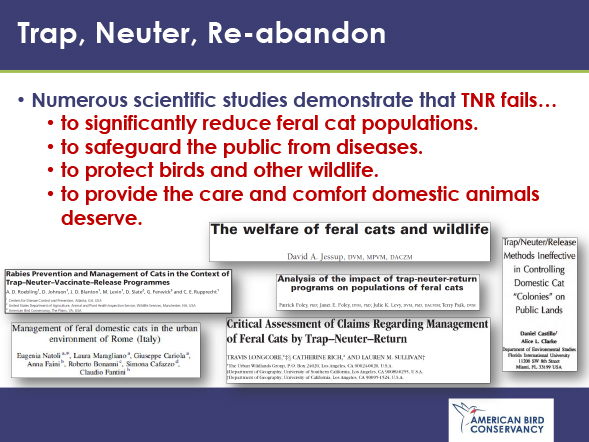
10. Determination in the face of contradictory evidence
Sizemore and ABC are nothing if not predictable. For years, they’ve been claiming—generally citing “research” that wouldn’t pass muster in a first-year graduate course (e.g., David Jessup’s 2004 paper) or misrepresenting legitimate work (e.g., Natoli et al.)—that “TNR doesn’t work.” Earlier this month, in fact, Sizemore did exactly this in an interview with NPR affiliate WVTF.
Contrary to ABC’s assertions, multiple research studies have documented the effectiveness of TNR to stabilize and reduce the population of cats at a local, or “colony” level, [14-19] as well as reduce shelter intake. [20] And the technique has even been recommended in areas of conservation-sensitive habitat. [21, 22] (As I explained in an August blog post, Sizemore and ABC actually do cite one of these studies, but only to take advantage of six words in the paper’s abstract—ignoring entirely the results.)
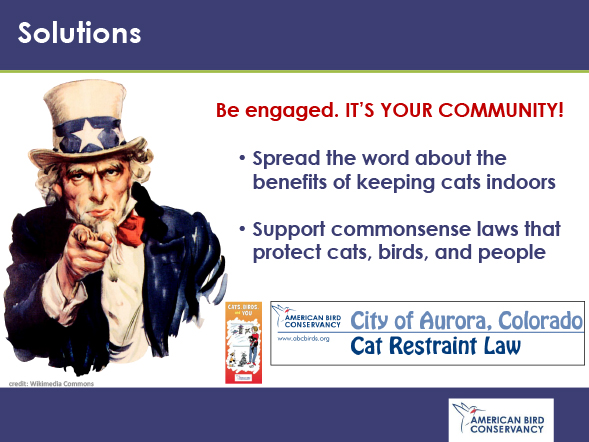
11. Embracing a 50% kill rate for shelters
According to a document (PDF) available from the ABC website, Aurora, Colorado’s “cat restraint law” would seem to be a model of local legislation that has “had great success with controlling cat populations, keeping cats healthier and safer, and protecting local wildlife.” Strange that ABC is citing ordinance changes enacted 20-plus years ago:
“Mandatory licensing and rabies vaccination have been required in Aurora since February 12, 1990. Mandatory spay/neuter, a prohibition on cats running loose, and limits on the number of cats per household became effective in 1994.” [23]
Haven’t they got more recent success stories? Apparently not.
In any case, there ought to be more than 20 years of data to demonstrate the effectiveness of Aurora’s “cat restraint law,” right?
ABC’s “evaluation demonstrating the positive impact of the ordinance” merely compares 1993, 1994, and 2011 data. And, yes, there appears to be some remarkable improvement—“just” 720 cats killed in 2011 compared to 1,445 and 1,218 in 1993 and 1994, respectively. But suggesting that this improvement is the result of Aurora’s 1990 and 1994 ordinance changes is quite a leap. ABC certainly provides no evidence of a causal link.
Data obtained via a public records request to Aurora’s Animal Care Division filled in some pieces of the puzzle. “Transfers” (which apparently weren’t done at all until 1993) peaked in 1994, for example, at 282. (In most subsequent years, transfers have for some reason been well below 100.)
Even setting aside the various issues that may have contributed to the decline in cats killed, there’s the rate of shelter killing for cats—which has remained essentially flat since 1996, at about 50 percent (see below). Remember: according to ABC Aurora is a model community, with “great success… controlling cat populations [and] keeping cats healthier and safer.” [23]
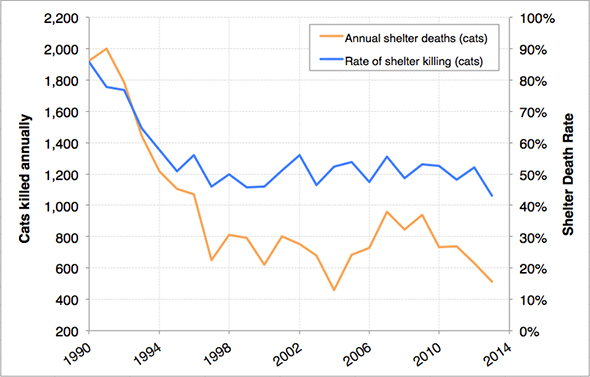
Depends which 50 percent we’re talking about, I suppose.
• • •
*I’ve e-mailed Kerrie Anne Loyd more than once inquiring about this, but she’s never responded.
Literature Cited
1. Grubbs, S.E. and P.R. Krausman, Observations of Coyote-Cat Interactions. Journal of Wildlife Management, 2009. 73(5): p. 683–685. http://dx.doi.org/10.2193/2008-033
2. Lee, I.T., et al., Prevalence of feline leukemia virus infection and serum antibodies against feline immunodeficiency virus in unowned free-roaming cats. Journal of the American Veterinary Medical Association, 2002. 220(5): p. 620–622. http://avmajournals.avma.org/doi/abs/10.2460/javma.2002.220.620
3. Little, S.E., Feline immunodeficiency virus testing in stray, feral, and client-owned cats of Ottawa. Canadian Veterinary Journal, 2005. 46(10): p. 898–901. http://www.ncbi.nlm.nih.gov/pmc/articles/PMC1255591/
4. Little, S., A review of feline leukemia virus and feline immunodeficiency virus seroprevalence in cats in Canada. Veterinary Immunology and Immunopathology, 2011. 143(3-4): p. 243–245. http://www.ncbi.nlm.nih.gov/pubmed/21757241
5. Fenwick, G.H. House cats: The destructive invasive species purring on your lap. The Baltimore Sun, 2013. http://www.baltimoresun.com/news/opinion/oped/bs-ed-cats-20130225,0,6415585.story
6. Rich, T.D., et al., Partners in Flight North American Landbird Conservation Plan, 2004, Cornell Lab of Ornithology: Ithaca, NY.
7. Loyd, K.A.T., et al., Quantifying free-roaming domestic cat predation using animal-borne video cameras. Biological Conservation, 2013. 160(0): p. 183–189. http://www.sciencedirect.com/science/article/pii/S0006320713000189
8. Paluska, M. Kitty cameras show Athens cats on the prowl. 2012. http://www.cbsatlanta.com/story/17711012/kitty-cameras-show-athens-cats-on-the-prowl
9. Moran, G.J., et al., Appropriateness of rabies postexposure prophylaxis treatment for animal exposures. Emergency ID Net Study Group. Journal of the American Medical Association, 2000. 284(8): p. 1001–1007. http://jama.jamanetwork.com/article.aspx?articleid=193015
10. Dyer, J.L., et al., Rabies surveillance in the United States during 2012. Journal of the American Veterinary Medical Association, 2013. 243(6): p. 805–815. http://avmajournals.avma.org/doi/abs/10.2460/javma.243.6.805
11. Roebling, A.D., et al., Rabies Prevention and Management of Cats in the Context of Trap–Neuter–Vaccinate–Release Programmes. Zoonoses and Public Health, 2013: p. n/a-n/a. http://dx.doi.org/10.1111/zph.12070
12. Krueger, W., et al., Drinking water source and human Toxoplasma gondii infection in the United States: a cross-sectional analysis of NHANES data. BMC Public Health, 2014. 14(1): p. 711. http://www.biomedcentral.com/1471-2458/14/711
13. VanWormer, E., et al., Toxoplasma gondii, Source to Sea: Higher Contribution of Domestic Felids to Terrestrial Parasite Loading Despite Lower Infection Prevalence. EcoHealth, 2013: p. 1–13. http://dx.doi.org/10.1007/s10393-013-0859-x
14. Levy, J.K., D.W. Gale, and L.A. Gale, Evaluation of the effect of a long-term trap-neuter-return and adoption program on a free-roaming cat population. Journal of the American Veterinary Medical Association, 2003. 222(1): p. 42–46. http://avmajournals.avma.org/doi/abs/10.2460/javma.2003.222.42
15. Nutter, F.B., Evaluation of a Trap-Neuter-Return Management Program for Feral Cat Colonies: Population Dynamics, Home Ranges, and Potentially Zoonotic Diseases, in Comparative Biomedical Department2005, North Carolina State University: Raleigh, NC. p. 224.
16. Natoli, E., et al., Management of feral domestic cats in the urban environment of Rome (Italy). Preventive Veterinary Medicine, 2006. 77(3-4): p. 180–185. http://www.sciencedirect.com/science/article/B6TBK-4M33VSW-1/2/0abfc80f245ab50e602f93060f88e6f9
http://www.carocat.eu/data/@feral_cats_in_rome.pdf
17. Mendes-de-Almeida, F., et al., The Impact of Hysterectomy in an Urban Colony of Domestic Cats (Felis catus Linnaeus, 1758). International Journal of Applied Research in Veterinary Medicine, 2006. 4(2): p. 134–141. http://www.jarvm.com/articles/Vol4Iss2/Mendes.pdf
18. Mendes-de-Almeida, F., et al., Reduction of feral cat (Felis catus Linnaeus 1758) colony size following hysterectomy of adult female cats. Journal of Feline Medicine & Surgery, 2011
19. Robertson, S.A., A review of feral cat control. Journal of Feline Medicine & Surgery, 2008. 10(4): p. 366–375.
20. Levy, J.K., N.M. Isaza, and K.C. Scott, Effect of high-impact targeted trap-neuter-return and adoption of community cats on cat intake to a shelter. The Veterinary Journal, 2014. 201(3): p. 269–274. http://www.sciencedirect.com/science/article/pii/S1090023314001841
21. Tennent, J. and C.T. Downs, Abundance and home ranges of feral cats in an urban conservancy where there is supplemental feeding: A case study from South Africa. African Zoology, 2008. 2: p. 218–229.
22. Tennent, J., C.T. Downs, and M. Bodasing, Management Recommendations for Feral Cat (Felis catus) Populations Within an Urban Conservancy in KwaZulu-Natal, South Africa. South African Journal of Wildlife Research, 2009. 39(2): p. 137–142. http://dx.doi.org/10.3957/056.039.0211
23. ABC, City of Aurora, Colorado: Cat Restraint Law, 2011, American Bird Conservancy.
